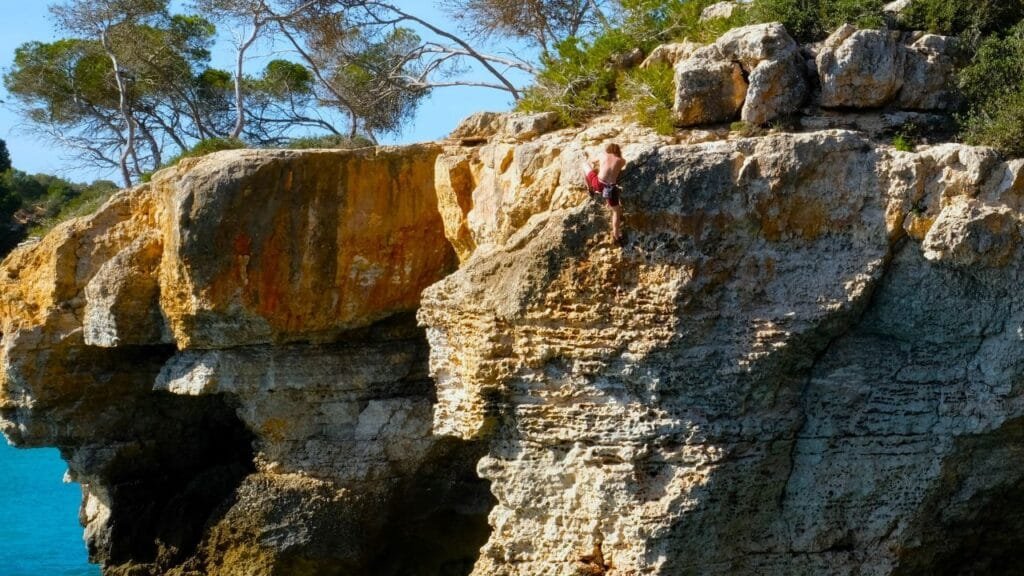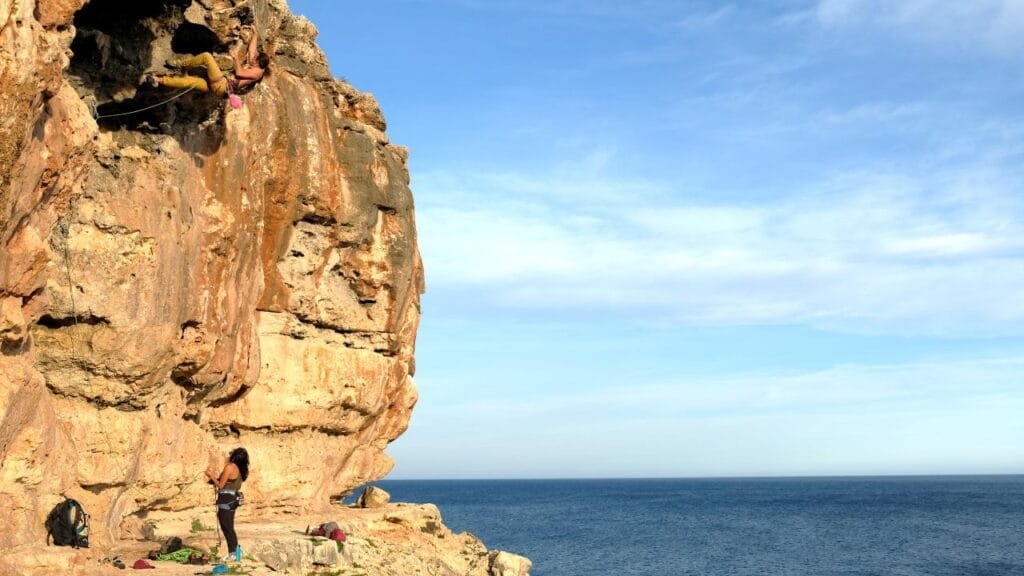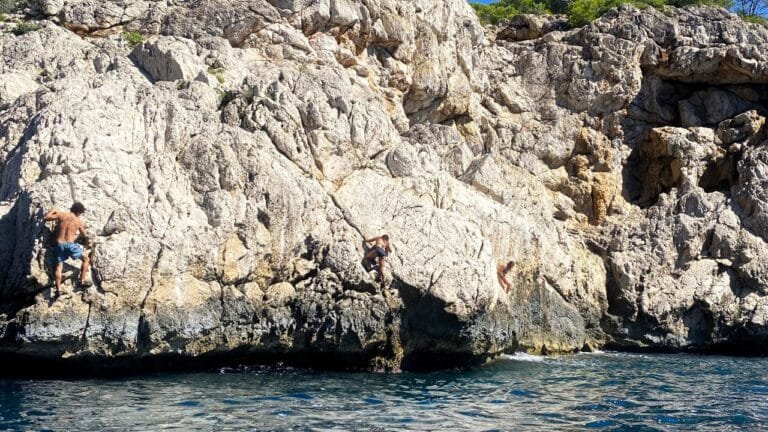Rock climbing is a sport that has inspired me beyond any other. When you are 20 meters off the ground, dangling off rocks from your fingertips, attempting to place safety gear before you fall, mental and physical fortitude are mandatory. Still, it can take years to build up this fortitude. Climbing demands consistent physical and mental upkeep; if you take time away from the sport, the muscles will slacken, and with them, the confidence to climb.
I, however, have taken to climbing relatively late in life; thus, the physicality of the sport is not – or cannot be – the whole of my attraction to it. Instead, it’s that climbing takes me to uncommon places.
Rock climbing happens in the nooks and crannies of earth. To reach them, I walk steep mountainsides on goat paths, bushwack down dried riverbeds, and wander behind abandoned bodegas to find beautiful cliffsides tucked away, alone and unknown to the surrounding population. These places would largely remain unvisited, vanishing behind overgrowth if climbers weren’t seeking them out. It is this exploration that allures me to climb. And it is for climbing that I moved to Mallorca.
One could argue that Mallorca is the best place on earth to go rock climbing.
Mallorca’s geography – a diamond-shaped island of limestone rising out of the Mediterranean Sea – is spectacular in beauty and function. In the south, the island’s flatlands drop drastically into the sea, leaving endless kilometers of wavesculpted cliffsides, caves, and dangling tuffas perfect for scaling. In the north, the land erupts upward into solid limestone mountains of all shapes – caverned, overhung, textured, and slabby – ideal for lengthy single and multi-pitch sport climbs. This landscape has made Mallorca a preeminent location for climbers, hosting pilgrimages of the world’s most elite and giving birth to the purest form of climbing imaginable, psicobloc.
Psicobloc Origins

When I was first told that climbing over the ocean was “invented” in Mallorca, I, admittedly, rolled my eyes. “Have you heard of Miguel Riera,” I was asked by numerous Mallorcans whenever I poured my heart out about the mecca that is Mallorca climbing. I had not. But soon, the name became unavoidable. I saw a teenager pass with “Miguel Riera” printed on his shirt, noticed his name under climbs in my guidebook, and noted the smiling, tanned, dark-haired islander in Mallorcan climbing documentaries.
Eventually, I put it together: psicobloc is what we call in English deep-water soloing, Mallorca is its birthplace, and Miguel Riera is its father.
Miguel Riera was born in Palma de Mallorca. In the 70s, as a child, he climbed with his friends, bouldering on the Porto Pi dam. Today, Porto Pi is known for its large American-style mall and enormous modern movie theater, but it’s also where Riera and his friends instinctually took climbing to the sea.
Like many places in Mallorca, Porto Pi is perched above seaside cliffs, so it was only natural that Riera and his friends extended their bouldering routes beyond solid earth and began traversing above the water. As they did, the foundations for what would become the renowned sport of psicobloc began.
Psicobloc as a Sport
The term psicobloc was coined by Riera and gets its name from the experience that climbing above water provides. Bouldering routes – which take place on huge fallen boulders often strewn across forest floors – usually stretch no more than 5-8 meters above the ground; beyond this height, a fall would result in injury, if not death.
Thus, climbing beyond 8 meters without a rope is often considered free soloing instead of bouldering. (Alex Honnold brought free soloing to the world’s attention in 2018 with his Oscar-winning documentary Free Solo.) But when it comes to psicobloc, the water, not the hard ground, breaks the climber’s fall, meaning that Riera and his friends felt confident climbing higher than they would on a bouldering route. They would climb 10 meters, 15 meters, even up to 20 meters above the water.
It is at these heights – past the threshold of bouldering heights – that you enter the “psycho zone.” You feel the height, you hear the waves crashing below you, you feel them shake the wall you cling to, and you tremble. When you reach the “psycho zone,” climbing is at its best because it is no longer just a test of physical strength but mental determination.
These heights and the relatively soft landing of water make psicobloc a unique sport within the world of climbing, and it was Miguel Riera’s dedication to the discovery and documentation of psicobloc routes that eventually pushed the sport into the public eye.
In the 80s, Riera and his friends traveled further afield and began opening more extensive routes in stunning locations across Mallorca. The indomitable wall of La Cova del Diable in Porto Cristo stretches 18 meters above the sea and offers some of the most challenging grades in the sport. Due to these heights and technicalities of climbing, Riera decided that more objective information was needed to guide climbers. Route lines, heights, grades for climbing difficulty, and grades for the perilousness of the fall were compiled.
The sport lay more or less dormant within Mallorca throughout the 90s, but sport climbing, another new style of rock climbing hailing from the Verdon Gorge of France, had made its way to the island.
Sport Climbing

Sport climbing is the most recognizable style of rock climbing. It occurs when a climber puts on a harness, ties it to a rope, and climbs up a rock wall, moving from one piece of bolted protection to the next. The installment of permanent bolts on the rock allows athletes to emphasize the sport’s athleticism (hence the term “sport” climbing). With a climber’s rope clipped to a permanent bolt, the climber can (relatively) safely fall repeatedly at a tricky section of the climb and thus practice specific moves.
When Jaume Payeras brought sport climbing to Mallorca in the early 80s, it had already taken off worldwide. Along with the father of psicobloc (among others), Payeras began bolting the spiring walls outside Bunyola known as Sa Gubia, effectively bringing sport climbing to Mallorca and opening a venue that is as stunning in its beauty as it is in its extensiveness.
Compared to the rest of the world, crags (designated climbing locations) developed slowly in Mallorca throughout the 90s. But then came the 2000s and Josh Powell and Chris Sharma along with it.
Oddly enough, the modern story of Mallorcan climbing begins in Park City, Utah. In 2004, a short documentary called “Psicobloc” premiered at the Sun Dance Film Festival in Park City – a film festival highly regarded as one of the world’s most important independent film festivals. In the documentary, Josh Powell films Austrian climber Klem Loskot and British climber Tim Emmett climbing upon cliffs and caves 18+ meters above the Mediterranean Sea on the coasts of Mallorca.
This is the first time the sport was filmed and the first time Mallorca was featured in a climbing documentary. Shortly after that, Loskot returned to Mallorca with Chris Sharma – one of the best climbers the world has ever known – and converted Sharma into a psicobloc maniac.
If Miquel Riera is the father of psicobloc, Chris Sharma is its poster child. In 2014, Sharma released the short documentary Mallorcan Dreams, in which he gushes about the island and the purest form of climbing, psicobloc. To this date, his ascent of the most arduous psicobloc climb ever accomplished on the eye-popping free-standing arch of Es Puntas in southern Mallorca has 3.6 million views on YouTube. Sharma took psicobloc mainstream with his stunning accents and helped promote psicobloc as a sport.
In 2013, in Park City, Utah – the same place psicobloc first appeared on the silver screen – Riera was there to witness as the sport he created had its first official competition. Sharma was the main organizer, bringing together some of the biggest names in climbing to compete on a 20-meter wall with plastic holds above a pool at Olympic Park.
Park City continues to hold yearly psicobloc competitions, but the official Piscobloc Open has moved to Montreal, Canada, where over 10,000 attend and prizes exceed $100,000. 2023 marked the 10th annual competition. Back in Mallorca, Port de Sóller just hosted their second psicobloc competition – The Miquel Riera Cup – this past September. As climbers learned of psicobloc through the documentaries, Sharma’s YouTube channel, and international competitions, they also began to note where it all began: the Balearic Isle of Mallorca. Beyond the seaside cliffs, the allure of towering limestone mountains has brought ever more sport climbers to the island.
Today, the impressive split canyon walls of Sa Gubia have over 150 sport climbing routes. The original Mallorcan climbing guide published by Rockfax in 1995 had only 12 sport climbing crags. The most recent edition has 34 sport climbing crags and 16 psicobloc locations; thus, development has been exponential. And this is only a glimpse into Mallorcan rock climbing. The undocumented crags and routes on the island must number in the hundreds, and the potential for future routes is mind-boggling.
Where to DWS in Mallorca:
Classic, world-renowned: Cova del Diablo
Historical artifact: Porto Pi
Beginner Cave: Cala Sa Nau
Most Popular : Cala Barques
Where to Sport Climb in Mallorca:
Grandest: Alaró
Oldest: Sa Gubia
Coolest: S’Estret

